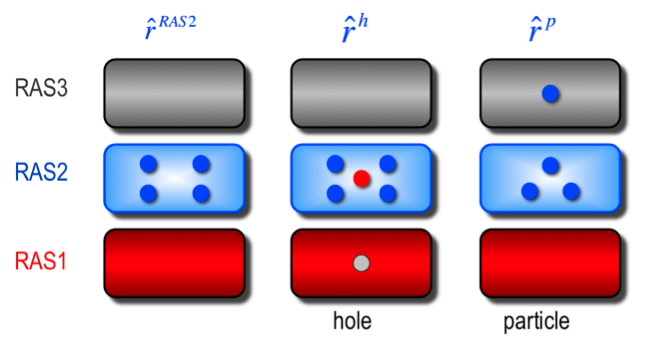Avoided crossings, conical intersections, and low-lying excited states with a single reference method: The restricted active space spin-flip configuration interaction approach.
Avoided crossings, conical intersections, and low-lying excited states with a single reference method: The restricted active space spin-flip configuration interaction approach
D. Casanova.
J. Chem. Phys., 137 (2012) 084105.

Schematic representation of the RAS-SF-CI wavefunction with up to one hole in RAS1 and one electron in RAS3.
The restricted active space spin-flip CI (RASCI-SF) performance is tested in the electronic structure computation of the ground and the lowest electronically excited states in the presence of near-degeneracies. The feasibility of the method is demonstrated by analyzing the avoided crossing between the ionic and neutral singlet states of LiF along the molecular dissociation. The two potential energy surfaces (PESs) are explored by means of the energies of computed adiabatic and approximated diabatic states, dipole moments, and natural orbital electronic occupancies of both states. The RASCI-SF methodology is also used to study the ground and first excited singlet surface crossing involved in the double bond isomerization of ethylene, as a model case. The two-dimensional PESs of the ground and excited states are calculated for the complete configuration space of torsion and pyramidalization molecular distortions. The parameters that define the state energetics in the vicinity of the conical intersection region are compared to CASSCF results. These examples show that it is possible to describe strongly correlated electronic states using a single reference methodology without the need to expand the wavefunction to high levels of collective excitations. Finally, RASCI is also examined in the electronic structure characterization of the ground and low-lying states of all-trans polyenes with two to seven double bonds and beyond. Transition energies are compared to TDDFT, CASSCF, and CASPT2 calculations, and to experimental data. The capability of RASCI-SF to describe the nature and properties of each electronic state is discussed in detail. This example is also used to expose the properties of different truncations of the RASCI wavefunction and to show the possibility to use an excitation operator with any number of α-to-β electronic promotions.
